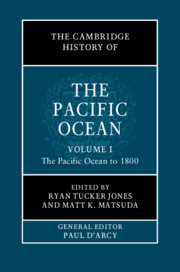50 results
Copyright page
-
- Book:
- The Cambridge History of the Pacific Ocean
- Published online:
- 11 November 2022
- Print publication:
- 05 January 2023, pp vi-vi
-
- Chapter
- Export citation
Part II - Humans and the Natural World in the Pacific Ocean
-
- Book:
- The Cambridge History of the Pacific Ocean
- Published online:
- 11 November 2022
- Print publication:
- 05 January 2023, pp 125-222
-
- Chapter
- Export citation
Figures
-
- Book:
- The Cambridge History of the Pacific Ocean
- Published online:
- 11 November 2022
- Print publication:
- 05 January 2023, pp xi-xii
-
- Chapter
- Export citation
Part III - Deep Time: Sources for the Ancient History of the Pacific
-
- Book:
- The Cambridge History of the Pacific Ocean
- Published online:
- 11 November 2022
- Print publication:
- 05 January 2023, pp 223-366
-
- Chapter
- Export citation
Frontispiece
-
- Book:
- The Cambridge History of the Pacific Ocean
- Published online:
- 11 November 2022
- Print publication:
- 05 January 2023, pp xvi-xvi
-
- Chapter
- Export citation
References to Volume I
-
- Book:
- The Cambridge History of the Pacific Ocean
- Published online:
- 11 November 2022
- Print publication:
- 05 January 2023, pp 718-818
-
- Chapter
- Export citation
Preface to Volume I
-
-
- Book:
- The Cambridge History of the Pacific Ocean
- Published online:
- 11 November 2022
- Print publication:
- 05 January 2023, pp 15-20
-
- Chapter
- Export citation
Contributors to Volume I
-
- Book:
- The Cambridge History of the Pacific Ocean
- Published online:
- 11 November 2022
- Print publication:
- 05 January 2023, pp xiv-xv
-
- Chapter
- Export citation
Contents
-
- Book:
- The Cambridge History of the Pacific Ocean
- Published online:
- 11 November 2022
- Print publication:
- 05 January 2023, pp vii-x
-
- Chapter
- Export citation
Part IV - The Initial Colonization of the Pacific
-
- Book:
- The Cambridge History of the Pacific Ocean
- Published online:
- 11 November 2022
- Print publication:
- 05 January 2023, pp 367-496
-
- Chapter
- Export citation
Index
-
- Book:
- The Cambridge History of the Pacific Ocean
- Published online:
- 11 November 2022
- Print publication:
- 05 January 2023, pp 819-852
-
- Chapter
- Export citation
Part I - Rethinking the Pacific
-
- Book:
- The Cambridge History of the Pacific Ocean
- Published online:
- 11 November 2022
- Print publication:
- 05 January 2023, pp 21-124
-
- Chapter
- Export citation
Part VI - Europe’s Maritime Expansion into the Pacific
-
- Book:
- The Cambridge History of the Pacific Ocean
- Published online:
- 11 November 2022
- Print publication:
- 05 January 2023, pp 633-717
-
- Chapter
- Export citation
Part V - The Evolution of Pacific Communities
-
- Book:
- The Cambridge History of the Pacific Ocean
- Published online:
- 11 November 2022
- Print publication:
- 05 January 2023, pp 497-632
-
- Chapter
- Export citation
Tables
-
- Book:
- The Cambridge History of the Pacific Ocean
- Published online:
- 11 November 2022
- Print publication:
- 05 January 2023, pp xiii-xiii
-
- Chapter
- Export citation

The Cambridge History of the Pacific Ocean
-
- Published online:
- 11 November 2022
- Print publication:
- 05 January 2023
Frontmatter
-
- Book:
- Pacific Worlds
- Published online:
- 05 June 2012
- Print publication:
- 19 January 2012, pp i-iv
-
- Chapter
- Export citation
12 - Extremities of the Great Southern Continent
-
- Book:
- Pacific Worlds
- Published online:
- 05 June 2012
- Print publication:
- 19 January 2012, pp 161-175
-
- Chapter
- Export citation
Notes
-
- Book:
- Pacific Worlds
- Published online:
- 05 June 2012
- Print publication:
- 19 January 2012, pp 379-412
-
- Chapter
- Export citation
Introduction: Encircling the ocean
-
- Book:
- Pacific Worlds
- Published online:
- 05 June 2012
- Print publication:
- 19 January 2012, pp 1-8
-
- Chapter
- Export citation



